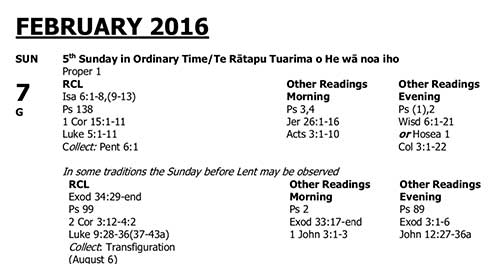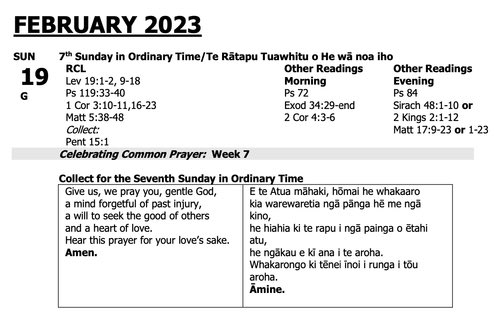
Let us pray (in silence) [that through our wisdom and love God is revealed]
Pause
Almighty God,
grant that we, meditating always on what is right and true,
may please you in word and deed;
through Jesus Christ, our Saviour
who is alive with you,
in the unity of the Holy Spirit,
one God, now and for ever.
Amen.
Commentary below (or Commentary on Ordinary 7 Opening Prayer).
In the pre-Vatican II counting, this coming Sunday is Quinquagesima. For some people, the Gospel reading this coming Sunday is that of the Transfiguration. That is an option in the Revised Common Lectionary.
Wednesday 22 February 2023 is Ash Wednesday (click link for the rite).
Resources beyond this site:
Textweek
Resourcing Preaching Down Under
Girardian Reflection on the Lectionary
Transfiguration
Many churches will, this coming Sunday (19 February, 2023), have the Transfiguration (Matthew 17:1-9) as their Gospel. The Revised Common Lectionary (RCL) has that as an option for the Sunday immediately prior to Lent. Best I can ascertain, this comes from a Lutheran (and possibly other) tradition of focusing on the Transfiguration on the Sunday immediately before the Gesima Sundays.
Here is the 1992 Revised Common Lectionary:
Year A (this year); Year B; Year C.
This 1992 RCL is an agreed and binding formulary of the Anglican Church in Aotearoa, New Zealand and Polynesia. Until 2017, the Transfiguration option for this coming Sunday was found in our Church lectionary booklet:

In the seven years since then, while the option (it is the Anglican Church of Or after all!) has continued to be there in our formal agreements, there has been no mention of the Transfiguration-on-the-Last-Sunday-before-Lent option in the Church lectionary booklet:
Furthermore, and possibly more concerning, I can see no mention of the Transfiguration option in the draft New Zealand Prayer Book printed in 2020 (and online).
Let me be clear: I am in favour of having the Transfiguration each year on the Second Sunday in Lent (from each of the three Synoptic Gospels rotating year by year), rather than prior to Lent – Transfiguration on Lent 2 is the practice of the majority of Christians, and so, doing so, increases the discipline and the experience of common prayer, it is a sign and a source of Christian unity.
But, until our Church has a (formulary) agreement that we all commemorate the Transfiguration on Lent 2, we have to be clear what we have agreed to. RCL has the options of Transfiguration on the Sunday before Lent or Lent 2 – and so RCL, obviously, provides an alternative Gospel on those Sundays. So, that alternative ought to be provided in our Church lectionary booklet:

Think this through now: it is possible the Transfiguration is not celebrated this coming Sunday; it is possible that the Transfiguration is ALSO not celebrated on Lent 2. There’s one other Transfiguration feast day – but it’s not a Sunday, August 6, and when it falls on a Sunday, the normal Sunday readings take precedence. So – let me be clear again: in NZ Anglicanism, it is possible to NEVER hear the Transfiguration story, a central story in the Gospels; one might never encounter this at Sunday church!
In summary: in the Anglican Church of Or, it is possible to celebrate the Transfiguration once, twice, or three times a year. Or never!
*****
Let us pray (in silence) [that we may grow into the likeness of Christ]
pause
Transfiguring God,
before the passion of your beloved Son
you revealed his glory on the holy mountain:
grant that we who by faith behold the light of his face
may be strengthened to bear the cross,
and be changed into his likeness from glory to glory;
through the same Jesus Christ
who is alive and reigns with you,
in the unity of the Holy Spirit,
one God, now and for ever.
Amen.
Commentary on the above collect.
Commentary on the Ordinary 7 Collect
The original was
Praesta, quaesumus, omnipotens Deus, ut, semper rationabilia meditantes, quae tibi sunt placita, et dictis exsequamur et factis.
This was a daily prayer in the Hadrianum (8th Century). In the Gelasian Sacramentary it was used in time of strife. From the eighth century until the Roman Missal of 1962 it moved between the fifth and sixth Sunday after Epiphany. It has been used as the collect in the Gathering rite, as a prayer after Communion, and as a prayer over the people at the end of the Eucharist. I cannot locate it in the Sarum Rite, and nor can I find it in any Anglican revision. It is the current collect for the Seventh Sunday in Ordinary Time in the Roman Rite.
What we pursue is also our motivation for pursuing those things that are pleasing to God. These are the focus of our meditation.
ICEL translation (1973):
Father,
keep before us the wisdom and love
you have revealed in your Son.
Help us to be like him
in word and deed.
In the failed 1998 English Missal translation:
Almighty God,
fix our hearts on what is right and true,
that we may please you always
by observing your will in both word and deed.
We ask this through our Lord Jesus Christ, your Son,
who lives and reigns with you in the unity of the Holy Spirit, God for ever and ever.
Current ICEL translation (2011):
Grant, we pray, almighty God,
that, always pondering spiritual things,
we may carry out in both word and deed
that which is pleasing to you.



Thank you for all you work. Much appreciated
Thanks for your encouragement, Larry. Blessings.